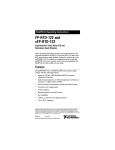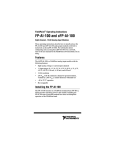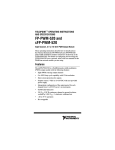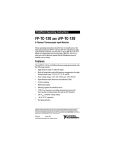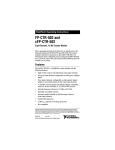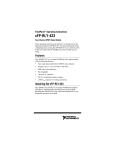Download FP-PWM-520 and cFP-PWM-520 Operating Instructions
Transcript
FieldPoint Operating Instructions FP-PWM-520 and cFP-PWM-520 Eight-Channel, 5 V or 10–30 V PWM Output Module These operating instructions describe how to install and use the National Instruments FP-PWM-520 and cFP-PWM-520 pulse-width modulation modules (referred to inclusively as the [c]FP-PWM-520). For details on configuring and accessing the [c]FP-PWM-520 over a network, refer to the user manual for the FieldPoint network module you are using. Features The [c]FP-PWM-520 is a FieldPoint pulse-width modulation (PWM) output module with the following features: • Eight PWM sourcing output channels • 0 to 100% duty-cycle capability with 12-bit resolution • Short-circuit protection for outputs • Outputs source 5 VDC or 10–30 VDC • Independent configuration of the output period for each channel from 1 to 65,535 ms in 1 ms increments • On/Off LED indicators • 2,300 Vrms transient overvoltage protection • –40 to 70 °C operation • Hot swappable FieldPoint™, National Instruments™, NI™, and ni.com™ are trademarks of National Instruments Corporation. Product and company names mentioned herein are trademarks or trade names of their respective companies. For patents covering National Instruments products, refer to the appropriate location: Help»Patents in your software, the patents.txt file on your CD, or ni.com/patents. 323357B-01 May 2003 © 2002–2003 National Instruments Corp. All rights reserved. Installing the FP-PWM-520 The FP-PWM-520 mounts on a FieldPoint terminal base (FP-TB-x), which provides operating power to the module. Installing the FP-PWM-520 onto a powered terminal base does not disrupt the operation of the bank. To install the FP-PWM-520, refer to Figure 1 and complete the following steps: 1. Slide the terminal base key to either position X, used for any module, or position 4, used for the FP-PWM-520 module. 2. Align the FP-PWM-520 alignment slots with the guide rails on the terminal base. 3. Press firmly to seat the FP-PWM-520 on the terminal base. When the module is firmly seated, the terminal base latch locks it into place. Key Latch Alignment Slot Guide Rails I/O Module Terminal Base Figure 1. Installing the FP-PWM-520 Installing the cFP-PWM-520 The cFP-PWM-520 mounts on a FieldPoint backplane (cFP-BP-x), which provides operating power to the module. Installing the cFP-PWM-520 onto a powered backplane does not disrupt the operation of the bank. To install the cFP-PWM-520, refer to Figure 2 and complete the following steps: 1. Align the captive screws on the cFP-PWM-520 with the holes on the backplane. The alignment keys on the cFP-PWM-520 prevent backward insertion. FP-PWM-520 and cFP-PWM-520 2 ni.com 2. Press firmly to seat the cFP-PWM-520 on the backplane. 3. Using a number 2 Phillips screwdriver with a shank of at least 64 mm (2.5 in.) length, tighten the captive screws to 1.1 N ⋅ m (10 lb ⋅ in.) of torque. The nylon coating on the screws prevents them from loosening. 4 3 5 2 4 2 1 1 cFP I/O Module 2 Captive Screws 3 cFP Controller Module 4 Screw Holes 5 cFP Backplane Figure 2. Installing the cFP-PWM-520 Wiring the [c]FP-PWM-520 The FP-TB-x terminal base has connections for each of the eight output channels and for an external power supply to power the output channels and field devices. The cFP-CB-x connector block provides the same connections. Each channel has one output terminal (VOUT ), one supply terminal (VSUP), and two common terminals (COM). All eight channels are referenced to the COM terminals. The V and VSUP terminals are all internally connected, as are the C and COM terminals. © National Instruments Corp. 3 FP-PWM-520 and cFP-PWM-520 Use a 5 VDC or 10–30 VDC external power supply for the output channels. The power supply must provide enough current to power all of the loads on the output channels, up to a maximum of 1 A per channel. Connect the external power supply to multiple V and VSUP terminals and to multiple C and COM terminals as needed to ensure that the maximum current through any terminal is 2 A or less. Install a 2 A maximum, fast-acting fuse between the external power supply and the VSUP terminal on each channel. Install a 1 A maximum, fast-acting fuse suitable for the load at the VOUT terminal. Figure 3 shows fuses where appropriate. C V VSUP Protected Sourcing Output 2 A max VOUT 1 A max 5 VDC or 10–30 VDC External – Power Supply + Load COM COM [c]FP-PWM-520 Figure 3. Wiring the [c]FP-PWM-520 Caution Maximum output current for the cFP-PWM-520 is lower than 1 A if the module is operating in the 50–70 °C temperature range. Refer to the Specifications section for more information, and select fuses for the VOUT terminals accordingly. Table 1 lists the terminal assignments for the signals of each channel. Terminal assignments are also listed on the side panel of the cFP-PWM-520 and under the slide-in card on the front of the FP-PWM-520. FP-PWM-520 and cFP-PWM-520 4 ni.com Table 1. Terminal Assignments Terminal Numbers 1 2 1 Channel VOUT VSUP2 COM 0 1 17 2, 18 1 3 19 4, 20 2 5 21 6, 22 3 7 23 8, 24 4 9 25 10, 26 5 11 27 12, 28 6 13 29 14, 30 7 15 31 16, 32 Install a 1 A maximum, fast-acting fuse on each VOUT terminal. Install a 2 A maximum, fast-acting fuse on each VSUP terminal. Pulse-Width Modulator Output Circuit The [c]FP-PWM-520 output channels are optically isolated from the rest of the FieldPoint bank. The channels are sourcing outputs with short-circuit protection circuitry. Sourcing current means that the VOUT terminal provides a path to a voltage supply. In the ON state of the output period, a transistor is turned on between VSUP and VOUT. In the OFF state, this transistor is turned off, allowing only a small leakage current to flow. In the ON state, the effective resistance between VOUT and VSUP is typically 0.3 Ω. This resistance causes a voltage drop between the external supply voltage and the output voltage. For example, if the external supply voltage is 5 V and the output current is 1 A, the output voltage is 4.7 V: 5 V – (1 A × 0.3 Ω) = 4.7 V Short-Circuit Protection If the protection circuitry detects a short-circuit condition on an output channel, it disables the output. If the protection circuitry disables an output that would otherwise be in the ON state, the status indicator for that channel is still lit, but the output transistor is turned off. © National Instruments Corp. 5 FP-PWM-520 and cFP-PWM-520 Detecting a Short-Circuit Condition To determine whether a channel is in a short-circuit condition, complete the following steps: 1. In FieldPoint software, set the duty cycle to 100% for the channel in question. Refer to the Configuring the Output Channels section for more information about configuring the duty cycle. 2. Measure the voltage between the VOUT and VSUP terminals for that channel. Under normal load conditions, the VOUT -to-VSUP voltage is less than 1 V when the output is ON continuously. Any voltage higher than 1 V indicates a short circuit. Typically, the VOUT -to-COM voltage is almost zero if the protection circuitry is activated. Resetting a Channel in a Short-Circuit Condition To reset a channel in a short-circuit condition, determine the cause of the condition and disconnect the load from the channel. The channel resets automatically when the load is removed. Alternatively, if completely removing the channel load is not convenient, reset the channel in any of the following ways: • In FieldPoint software, set the duty cycle to 0%. The channel resets immediately. • Disconnect the external power supply from the [c]FP-PWM-520. • Remove the [c]FP-PWM-520 from the terminal base or backplane. • Power off the network module connected to the [c]FP-PWM-520. Normal operation can resume after you correct the short-circuit condition. FP-PWM-520 and cFP-PWM-520 6 ni.com Configuring the Output Channels A [c]FP-PWM-520 output channel uses period and duty-cycle settings to determine when the channel is on or off. To configure the period, complete the following steps in the FieldPoint software: 1. In the Channel Configuration dialog box, select Period from the Attribute menu. 2. Enter an integer between 1 ms (1 kHz) and 65,535 ms (0.01525 Hz) in the Value field. To configure the duty cycle, write to the channel for which you want to set the duty cycle. The duty cycle is the proportion of time that the PWM signal is ON over the period. On Time Duty Cycle = -------------------- × 100 Period Enter a value from 0 to 100 to set the duty cycle. The duty cycle has 12-bit resolution (4,096 discrete duty-cycle settings). 2 2 VSUP 1 0 3 1 PWM Output 3 2 On Time 3 Period Figure 4. Period and Duty Cycle of a PWM Output © National Instruments Corp. 7 FP-PWM-520 and cFP-PWM-520 Status Indicators Figure 5 shows the status indicator LEDs on the [c]FP-PWM-520. Figure 5. Status Indicators The [c]FP-PWM-520 has two green status LEDs, POWER and READY. After you insert the FP-PWM-520 onto a terminal base or the cFP-PWM-520 onto a backplane and apply power to the connected network module, the green POWER indicator lights and the [c]FP-PWM-520 informs the network module of its presence. When the network module recognizes the [c]FP-PWM-520, it sends initial configuration information to the [c]FP-PWM-520. After the [c]FP-PWM-520 receives this initial information, the green READY indicator lights and the module is in normal operating mode. In addition to the green POWER and READY indicators, each channel has a numbered, green status LED that lights when the channel is in the ON state. Upgrading Your FieldPoint Firmware You may need to upgrade your FieldPoint firmware when you add new I/O modules to your FieldPoint system. For information on determining which firmware you need and how to upgrade your firmware, go to ni.com/info and enter fpmatrix. Isolation and Safety Guidelines Read the following information before attempting to connect the [c]FP-PWM-520 to any circuits that may contain hazardous voltages. Caution This section describes the isolation of the [c]FP-PWM-520 and its compliance with international safety standards. The field wiring connections are isolated from the backplane and the inter-module communication bus. The isolation is provided by the module, which has optical and galvanic isolation barriers designed and tested to protect against transient fault voltages of up to 2,300 Vrms. FP-PWM-520 and cFP-PWM-520 8 ni.com Follow these guidelines to ensure a safe total system. • The [c]FP-PWM-520 has a safety isolation barrier between the I/O channels and the inter-module communication bus. There is no isolation between channels unless otherwise noted. If any of the channels on a module are wired at a hazardous potential, make sure that all other devices or circuits connected to that module are properly insulated from human contact. • Do not share the external supply voltages (the V and C terminals) with other devices (including other FieldPoint devices), unless those devices are isolated from human contact. • For Compact FieldPoint, you must connect the protective earth (PE) ground terminal on the cFP-BP-x backplane to the system safety ground. The backplane PE ground terminal has the following symbol stamped beside it: . Connect the backplane PE ground terminal to the system safety ground using 14 AWG (1.6 mm) wire with a ring lug. Use the 5/16 in. panhead screw shipped with the backplane to secure the ring lug to the backplane PE ground terminal. • As with any hazardous voltage wiring, make sure that all wiring and connections meet applicable electrical codes and commonsense practices. Mount terminal bases and backplanes in an area, position, or cabinet that prevents accidental or unauthorized access to wiring that carries hazardous voltages. • Operate the [c]FP-PWM-520 only at or below Pollution Degree 2. Pollution Degree 2 means that only nonconductive pollution occurs in most cases. Occasionally, however, a temporary conductivity caused by condensation must be expected. • Refer to the FieldPoint product label for regulatory certification under hazardous location standards. If the FieldPoint product is not certified for operation in hazardous locations, do not operate it in an explosive atmosphere or where there may be flammable gases or fumes. © National Instruments Corp. 9 FP-PWM-520 and cFP-PWM-520 Specifications The following specifications are typical for a range of –40 to 70 °C unless otherwise noted. Output Characteristics Number of channels.......................... 8 Output type ....................................... Sourcing Output voltage .................................. Supply voltage – (Output current × Output impedance) Supply voltage .................................. 5 VDC or 10 to 30 VDC, user-provided Maximum output current Per channel Temperature Ranges Module –40 to 50 °C 50 to 60 °C 60 to 70 °C cFP-PWM-520 1A 0.75 A 0.5 A FP-PWM-520 1A 1A 1A Output impedance............................. 0.3 Ω typical Pulse-width accuracy ........................ –1, +3 µs, any period and duty cycle Physical Characteristics Indicators .......................................... Green POWER and READY indicators, eight green output state indicators Weight FP-PWM-520 ............................. 140 g (4.9 oz) cFP-PWM-520 ........................... 110 g (3.9 oz) Power Requirements Power from network module ............ 1 W Isolation Voltage Channel-to-channel isolation ............ No isolation between channels Transient overvoltage........................ 2,300 Vrms FP-PWM-520 and cFP-PWM-520 10 ni.com Environmental FieldPoint modules are intended for indoor use only. For outdoor use, they must be mounted inside a sealed enclosure. Operating temperature ...................... –40 to 70 °C Storage temperature .......................... –55 to 85 °C Humidity ........................................... 10 to 90% RH, noncondensing Maximum altitude............................. 2,000 m; at higher altitudes the isolation voltage ratings must be lowered Pollution Degree ............................... 2 Shock and Vibration These specifications apply only to the cFP-PWM-520. NI recommends Compact FieldPoint if your application is subject to shock and vibration. Operating vibration, random (IEC 60068-2-64).............................. 10–500 Hz, 5 grms Operating vibration, sinusoidal (IEC 60068-2-6)................................ 10–500 Hz, 5 g Operating shock (IEC 60068-2-27).............................. 50 g, 3 ms half sine, 18 shocks at 6 orientations; 30 g, 11 ms half sine, 18 shocks at 6 orientations Safety This product is designed to meet the requirements of the following standards of safety for electrical equipment for measurement, control, and laboratory use: • IEC 61010-1, EN 61010-1 • UL 3121-1, UL 61010C-1 • CAN/CSA C22.2 No. 1010.1 For UL, hazardous location, and other safety certifications, refer to the product label or to ni.com. © National Instruments Corp. 11 FP-PWM-520 and cFP-PWM-520 Electromagnetic Compatibility CE, C-Tick, and FCC Part 15 (Class A) Compliant Emissions.......................................... EN 55011 Class A at 10 m FCC Part 15A above 1 GHz Immunity........................................... EN 61326:1997 + A2:2001, Table 1 Note For EMC compliance, you must operate this device with shielded cabling. CE Compliance This product meets the essential requirements of applicable European Directives, as amended for CE Marking, as follows: Low-Voltage Directive (safety)......... 73/23/EEC Electromagnetic Compatibility Directive (EMC) ............................... 89/336/EEC Note Refer to the Declaration of Conformity (DoC) for this product for any additional regulatory compliance information. To obtain the DoC for this product, click Declarations of Conformity Information at ni.com/hardref.nsf/. Mechanical Dimensions Figure 6 shows the mechanical dimensions of the FP-PWM-520 installed on a terminal base. If you are using the cFP-PWM-520, refer to your Compact FieldPoint controller user manual for the dimensions and cabling clearance requirements of the Compact FieldPoint system. 107.19 mm (4.22 in.) 109.5 mm (4.31 in.) 91.44 mm (3.60 in.) Figure 6. FP-PWM-520 Mechanical Dimensions FP-PWM-520 and cFP-PWM-520 12 ni.com Where to Go for Support For more information about setting up the FieldPoint system, refer to these National Instruments documents: • FieldPoint network module user manual • Other FieldPoint I/O module operating instructions • FieldPoint terminal base and connector block operating instructions Go to ni.com/support for the most current manuals, examples, and troubleshooting information. For telephone support in the United States, create your service request at ni.com/ask and follow the calling instructions or dial 512 795 8248. For telephone support outside the United States, contact your local branch office: Australia 1800 300 800, Austria 43 0 662 45 79 90 0, Belgium 32 0 2 757 00 20, Brazil 55 11 3262 3599, Canada (Calgary) 403 274 9391, Canada (Montreal) 514 288 5722, Canada (Ottawa) 613 233 5949, Canada (Québec) 514 694 8521, Canada (Toronto) 905 785 0085, Canada (Vancouver) 514 685 7530, China 86 21 6555 7838, Czech Republic 420 2 2423 5774, Denmark 45 45 76 26 00, Finland 385 0 9 725 725 11, France 33 0 1 48 14 24 24, Germany 49 0 89 741 31 30, Greece 30 2 10 42 96 427, India 91 80 51190000, Israel 972 0 3 6393737, Italy 39 02 413091, Japan 81 3 5472 2970, Korea 82 02 3451 3400, Malaysia 603 9131 0918, Mexico 001 800 010 0793, Netherlands 31 0 348 433 466, New Zealand 1800 300 800, Norway 47 0 66 90 76 60, Poland 48 0 22 3390 150, Portugal 351 210 311 210, Russia 7 095 238 7139, Singapore 65 6226 5886, Slovenia 386 3 425 4200, South Africa 27 0 11 805 8197, Spain 34 91 640 0085, Sweden 46 0 8 587 895 00, Switzerland 41 56 200 51 51, Taiwan 886 2 2528 7227, Thailand 662 992 7519, United Kingdom 44 0 1635 523545 © National Instruments Corp. 13 FP-PWM-520 and cFP-PWM-520













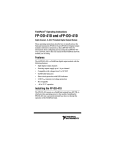
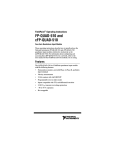
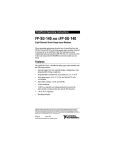
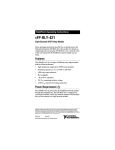
![[c]FP-DO-401 Operating Instructions](http://vs1.manualzilla.com/store/data/005693758_1-4b10a2df6965457ee651014d1377996a-150x150.png)
